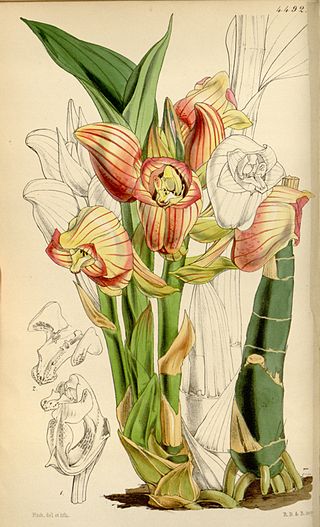
Acanthophippium is a genus of orchid with thirteen species. The name of this genus is derived from the Greek words acanthos ("spiny") and ephippion ("saddle"), referring to the saddle-like labellum of the plants.
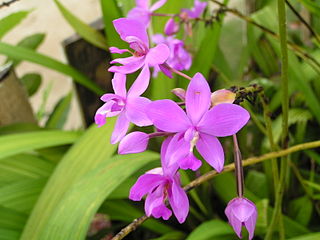
Spathoglottis, commonly known as purple orchids or 苞舌兰属 is a genus of about fifty species of orchids in the family Orchidaceae. They are evergreen terrestrial herbs with crowded pseudobulbs, a small number of leaves and medium-sized resupinate flowers on an upright flowering stem. The sepals and petals are all similar to each other and are white, yellow, pink or purple. Species of Spathoglottis are found from eastern and south-eastern Asia to Australia and some Pacific Islands.

Apostasia, commonly known as grass orchids, is a genus of eight species of primitive orchids in the family Orchidaceae. They are terrestrial, evergreen, grass-like plants, barely recognisable as orchids and are distributed in humid areas of the Himalayan region, China, India, Sri Lanka, Southeast Asia, New Guinea, and Queensland. They have many narrow leaves and small yellow or white, non-resupinate, star-like flowers usually arranged on a branched flowering stem.
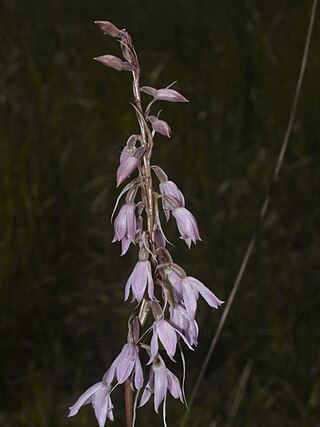
Pachystoma, commonly known as kunai orchids or 粉口兰属 , is a genus of two species of flowering plants in the orchid family, Orchidaceae. They are deciduous, terrestrial herbs with one or two linear, pleated or veiny leaves and more or less drooping flowers which do not open widely, on a thin, wiry flowering stem. Species in this genus are found in tropical and subtropical Asia to Australia and islands of the southwest Pacific Ocean.
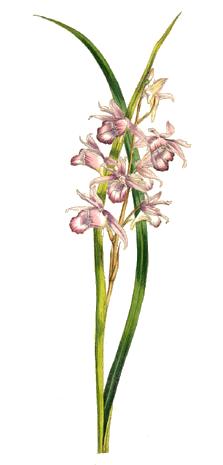
Phaius, commonly known as swamp orchids or in Chinese as 鶴頂蘭屬/鹤顶兰属 , is a genus of forty-five species of flowering plants in the orchid family, Orchidaceae. They are evergreen, terrestrial herbs which form clumps with crowded, sometimes stem-like pseudobulbs, large, pleated leaves and relatively large, often colourful flowers. Species in this genus are found in the tropical parts of Africa, Asia, Southeast Asia, New Guinea, Australia, and various islands of the Pacific and Indian Oceans. One species is also naturalized in Hawaii, Florida, and the Caribbean.
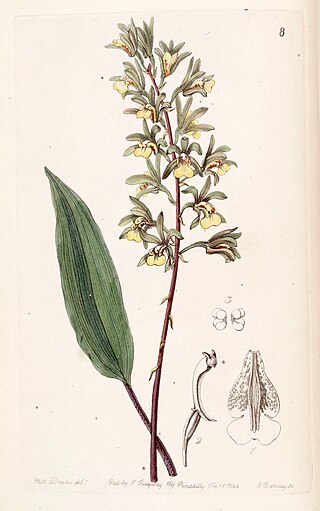
Tainia, commonly known as ribbon orchids or 带唇兰属 is a genus of about thirty species of evergreen, terrestrial orchids in the distributed from India, China, Japan, Southeast Asia to New Guinea, the Solomon Islands and Queensland.

Acriopsis, commonly known as chandelier orchids or 合萼兰属 is a genus of flowering plants in the family Orchidaceaes. Orchids in this genus are epiphytic herbs with spherical or cylindrical pseudobulbs, creeping, branched rhizomes, thin white roots, two or three leaves and many small flowers. The flowers are non-resupinate with the lateral sepals joined along their edges and have spreading petals and a three-lobed labellum. The column has projections that extend hood-like beyond the anther.

Crepidium, commonly known as 沼兰属 or spur orchids is a genus of about three hundred species of orchids in the family Orchidaceae. Plants in this genus are evergreen, mostly terrestrial plants with short stems lying on the ground, two or more relatively large, pleated leaves and small, non-resupinate flowers with spreading sepals and petals. The genus is widely distributed in the tropics.

Acriopsis javanica is a species of orchid that is native to Southeast Asia, New Guinea, some Pacific islands and northern Australia. It is a clump-forming epiphyte with dark green leaves and curved, branching flower stems with many white and cream-coloured flowers with purple markings.

Thelasis, commonly known as fly orchids, is a genus of flowering plants from the orchid family, Orchidaceae. Plants in this genus are usually epiphytes, sometimes lithophytes or rarely terrestrials. Some species have pseudobulbs with up to three leaves, whilst others have several leaves in two ranks. A large number of small, white or greenish yellow flowers are borne on a thin, arching flowering stem. There are about thirty species, distributed from tropical and subtropical Asia to the southwest Pacific.

Hetaeria, commonly known as hairy jewel orchids, is a genus of about thirty species of flowering plants in the orchid family Orchidaceae. Plants in this genus are terrestrial herbs with a succulent rhizome and a loose rosette of leaves. Small, pale, hairy non-resupinate flowers are borne on a thin, hairy flowering stem. They are found in tropical Africa and Asia to New Guinea, Australia and some Pacific Islands.

Phaius tankervilleae, commonly known as the greater swamp-orchid, swamp lily, swamp orchid, nun's-hood orchid, nun's orchid, veiled orchid, Lady Tankerville's swamp orchid or 鹤顶兰 , is a species of orchid native to areas from Asia to islands in the Pacific Ocean. It has large, pleated leaves and tall flowering stems bearing up to twenty five white, brown, mauve and yellow flowers. It was named for Lady Tankerville who was the first person to make the orchid flower successfully in England. It was the first tropical orchid to flower in England.

Spathoglottis paulinae, commonly known as the small purple orchid, is a plant in the orchid family and is native to New Guinea and Tropical North Queensland. It is an evergreen terrestrial orchid with crowded pseudobulbs, between four and seven large, pleated leaves and up to thirty mauve to purple flowers.

Hetaeria oblongifolia, commonly known as the hairy jewel orchid, is a species of orchid that is native to Southeast Asia, New Guinea and Queensland. It has between four and eight egg-shaped, dark green leaves and up to forty five small, hairy green and white flowers with a deep pouch near the base of the labellum.

Goodyera rubicunda, commonly known as the giant jewel orchid, is a species of orchid that is native to parts of India, Asia, Southeast Asia, New Guinea, Queensland and some Pacific Islands where it grows in damp forest and rainforest. It has between three and six large, egg-shaped leaves and up to ten dull pink and white resupinate flowers that are hairy on the outside.
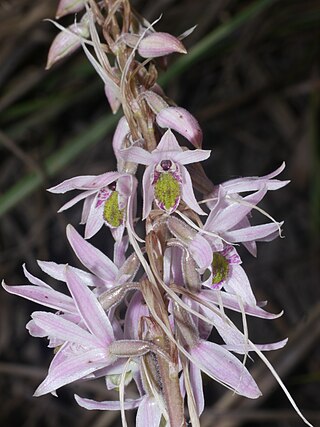
Pachychila pubescens, commonly known as pink kunai orchid or as 粉口兰 , is a plant in the orchid family. It is native to areas from Asia through Southeast Asia to New Guinea and northern Australia. It is a deciduous, terrestrial herb with one or two grass-like leaves and up to ten dull pink, more or less drooping flowers. It grows in wet, grassy places in forests and woodlands.
Dendrobium convexum, commonly known as the piggyback orchid, is an epiphytic orchid in the family Orchidaceae. It has a creeping, brittle root, erect pseudobulbs with a single leaf on the top and one or two cream-coloured, short-lived flowers with a red and yellow labellum. It is native to Southeast Asia, New Guinea and tropical North Queensland, Australia.
Bryobium retusum, commonly known as Christmas Island urchin orchid, is an epiphytic clump-forming orchid that has oval, fleshy green pseudobulbs, each with two leaves and between seven and twelve short-lived, self-pollinating, pale green, hairy flowers. This orchid is found between Java and New Caledonia.
Thelasis capitata, commonly known as the conical fly orchid, is a plant in the orchid family. It is a clump-forming epiphyte with flattened pseudobulbs, each with a single strap-shaped leaf. A large number of small yellowish green flowers are arranged in a cone shape on a thin but stiff flowering stem. This orchid is found from Thailand to Malesia, including on Christmas Island.

Thelasis carinata, commonly known as the triangular fly orchid, is a plant in the orchid family. It is a clump-forming epiphyte or lithophyte that lacks pseudobulbs. There are groups of between two and six erect, flattened stems each with up to six leaves that have a ridged lower surface. Up to fifteen green and white flowers are arranged on a thin but stiff flowering stem. This orchid is found from Thailand to the southwest Pacific.




















